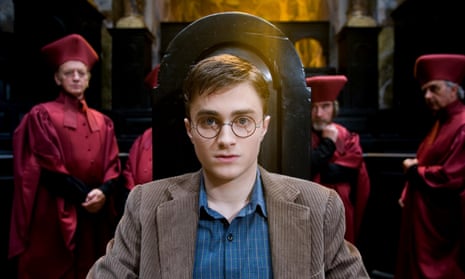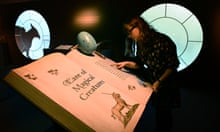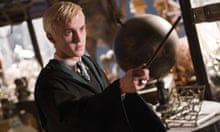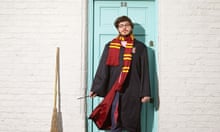1 Some first editions can appreciate in value pretty fast. There were only 500 hardback copies of Harry Potter and the Philosopher’s Stone printed in the first run in 1997, of which 300 went to libraries. If you find one of these knocking about in your downstairs loo – the print line on the copyright page is 10 9 8 7 6 5 4 3 2 1 – it’s worth a small fortune. Expect upwards of £30,000 for it. Fun fact: there was one of these in the Daily Telegraph’s books cupboard for many years, but it mysteriously went missing in the early noughties. If you’re the bastard who stole it, please have a word with the paper’s former literary editor, Kate Summerscale.
2 Even Homer nods. In Harry Potter and the Goblet of Fire, Harry is fighting a duel with Voldemort when he accidentally does something (Priori Incantatem) that causes the Dark Lord’s wand to spit out, in reverse order, spectral images of the people he has killed. Harry’s father, James, comes out before his mother, Lily – when, according to the established story, he died in the process of trying to help his wife and child escape. Fans feverishly speculated as to whether JK Rowling was setting up some crafty plot twist. She eventually admitted it was a mistake (Erratum Cockupis Normalis), due to “late-night writer’s fatigue”; the text was corrected in later editions.
3 Hindsight is a wonderful thing. The release of Harry Potter and the Philosopher’s Stone, on 26 June 1997, passed practically unnoticed. That day, people were more interested in the news of the election of Bertie Ahern (remember him?) as taoiseach of the Irish Republic. They were still making a fuss about Cool Britannia (remember that?) and the fresh-faced, new prime minister, Tony Blair (remember him?); going bananas about the Spice Girls (remember them?), and wondering about Diana, Princess of Wales’ love life. The bestselling novel of that year was a John Grisham.
4 Children’s books can be political. Rowling’s brilliant decision was to have her characters grow up at the same rate as her readers. Each book was set in one school year, and grew longer, darker and more adult in theme. By the time we reached book four, Goblet of Fire, we were seeing do-gooding Hermione’s Society for the Promotion of Elfish Welfare formed in response to the bond slavery of these sock-loving poppets. In the person of the hack journalist Rita Skeeter, Rowling sent up the tabloid press. The ministry of magic sent up Whitehall bureaucracy. And, as any fool could plainly see, the story’s master narrative – with purebloods fighting a war of annihilation against “mudbloods” – is about the struggle against your basic blood-and-soil fascism.
5 Academics can give us all a laugh. Harry Potter studies is a flourishing corner of the humanities and theory industry. See “The Hippogriff in Harry Potter As a Prime Example for Intertextuality”, “No Grace for James: James Potter and the Noble Heathen”, “Harry Potter and the Chamber of Secrets: A Psychoanalytic Viewpoint”, and “From the Holocaust to 9/11: Harry Potter and the Contemporary Struggle with Evil” for details.
6 Some people can be as dumb as stumps. In several places in the US, copies of Rowling’s books were burned by fundamentalist Christians who believed they were encouraging children to take up witchcraft. “Behind that innocent face is the power of satanic darkness,” said pastor Jack Brock of the Christ Community church in Alamogordo, New Mexico, in 2001. “Harry Potter is the devil and he is destroying people.”

7 Coffee shops were a good place to write even before Starbucks. Joanne Rowling, famously, wrote the first book as a single mother on benefits while eking out cuppas in Nicholson’s cafe and the back room of the Elephant House in Edinburgh. The former is now a Chinese restaurant and the latter is so popular with tourists, you might struggle to get a book written there.
8 There are three Unforgivable Curses. No, not that, or that, and certainly not that: wash your mouth out! I mean the three naughtiest curses in the armoury of the Death Eaters. As proscribed in 1717 by the Ministry of Magic, the use of any one of them will get you a one-way ticket to Azkaban, with no time off for good behaviour. They are the Imperius Curse (“Imperio”: for mind control), the Cruciatus Curse (“Crucio”: for torture) and baddest of all, the Killing Curse (“Avada Kedavra”: self-explanatory). If you say the last one slightly wrong – “Aveda Kedavra” – you inflict soft, clear, youthful-looking skin on your victim.
9 You could sell children’s books to grownups. The craze for Harry Potter got so febrile that, in order to cater to a market of grownups wishing to enjoy his adventures but embarrassed to be seen reading children’s books in public, in 1998 Bloomsbury released the first so-called “adult” edition. Not with added smut, just with more sombrely designed covers.
10 Some books are so secret you can’t even share them with their translators. At the height of the madness – roughly, Goblet onwards – the midnight launches were so tightly policed that translators didn’t get their copies until the English-language edition was in the shops. French translators, for instance, worked in teams and non-stop; every hour that passed saw the English edition cannibalising potential sales.
11 Some people were never going to go for it. In retrospect, AS Byatt might have been the wrong person for the New York Times to commission to appraise the series’ success. “Ms Rowling’s world is a secondary secondary world, made up of intelligently patchworked derivative motifs from all sorts of children’s literature,” she wrote in apparent bafflement. “It is written for people whose imaginative lives are confined to TV cartoons, and the exaggerated mirror-worlds of soaps, reality TV and celebrity gossip.” She wasn’t being intentionally bitchy, only rigorous, but it made her about as popular as a coldsore with the true believers.
12 There’s more than one way to skin a copyright cat. Try selling your own story set in Hogwarts and see where it gets you (hint: court). But Rowling and her publishers have been imaginative enough to see that online fan fiction is a rich way for enthusiasts to participate in her world; not to mention helping sustain the craze. She has given her official blessing, with two caveats: don’t publish it commercially, and no smut.

13 The publisher is mightier than the supermarket. During the launch-day kerfuffle around Deathly Hallows, Asda accused Bloomsbury of “blatant profiteering” and “attempting to hold children to ransom” by pricing the book at £17.99. Bloomsbury threatened a libel suit – and, which may have been the clincher, cancelled Asda’s order of half a million hardbacks. “If they want their 500,000 books, they’ll have to come and make peace with us,” Bloomsbury said. “It could be good news for all their disappointed customers, because they don’t have to go to a soulless Asda shed to buy their book.” Asda took less than a day to make a grovelling reversal to get some books for their soulless sheds.
14 You can sell any old cobblers if it’s associated with Harry Potter. There was some legal trouble when one entrepreneur started selling Harry Potter condoms, but that’s just the tip of the wand. Still, probably the jewel in the crown of inane Hogwarts merchandise was the (now discontinued) Nimbus 2000 vibrating plastic broom sold by Mattel. “I’m 32 and enjoy riding the broom as much as my 12-year-old and 7-year-old,” read one typical reader review on Amazon.
15 Writers can get a taste for violence. Those who don’t know the books may imagine them to be sentimental. But, oh boy, did old JK get slap-happy as the series went on. According to the main Potter fandom wiki “158 known individuals have been confirmed to have died”. By the last couple of books, major characters dropped like flies. I won’t say which, other than – spoiler – most of them.
16 Booksellers made barely a bean from some of the bestselling books in history. Supermarkets punted the books out below cost as a loss-leader; independents, in many cases, replenished their stocks from Tesco, as it was cheaper to buy there than from the publisher. Imagine if the Net Book Agreement had still been in force.
17 Boarding schools might be fun. After decades of decline, boarding schools reported a surge in applications from the late 1990s which headteachers attributed to the “Harry Potter effect”. Some set about building more boarding houses to cope with the demand. Alex Renton, author of a polemic against these schools, Stiff Upper Lip, points out that like the authors of most boarding-school stories, Rowling went to a day school.
18 Any good writer can change gear. Rowling’s first novel for grownups, The Casual Vacancy, addressed matters of class, politics and religion, discussed drug abuse and rape, and had a sex scene that saw it nominated for Literary Review’s bad sex award but rejected, the judges said, because “the writing was not nearly bad enough”.
19 You can never stay anonymous. Rowling, like Stephen King, tried seeing what would happen if a bestselling author published pseudonymously. The first Cormoran Strike thriller, 2013’s The Cuckoo’s Calling, appeared on the shelves under the nom de plume of Robert Galbraith (supposedly “a former plainclothes Royal Military Police investigator”) and was well received. It took all of three months for the Sunday Times to out Rowling as the author.
20 There’s always a bit more. Though Rowling has concluded the series, she hasn’t left the characters alone. As well as the play Harry Potter and the Cursed Child and the 18,000 words of additional content on the original Pottermore website, Rowling produced real-life versions of in-universe books: Quidditch Through the Ages, Fantastic Beasts and Where to Find Them and The Tales of Beedle the Bard. The holy grail of Potter apocrypha for book dealers is the 800‑word prequel she wrote on a postcard in 2008. It raised £25,000 at a charity auction for English PEN. But its whereabouts are now unknown, having vanished in a burglary earlier this year.








Comments (…)
Sign in or create your Guardian account to join the discussion